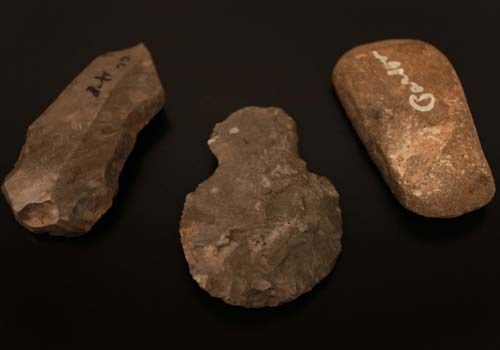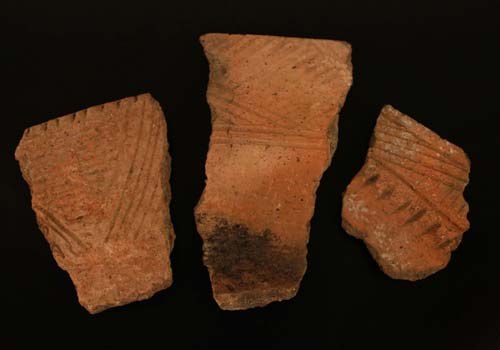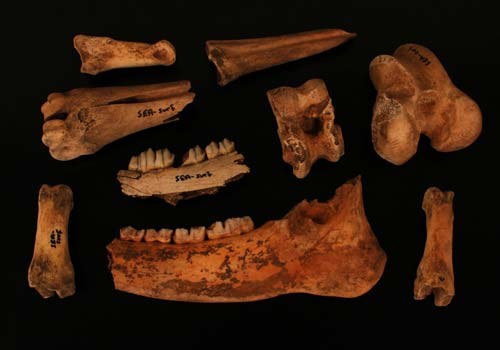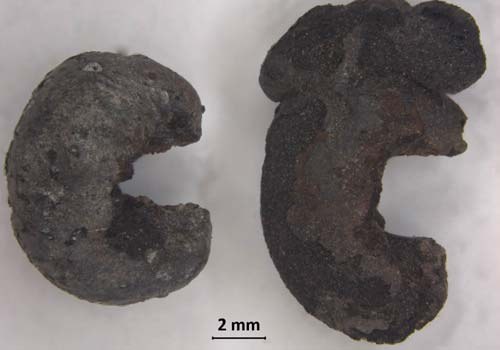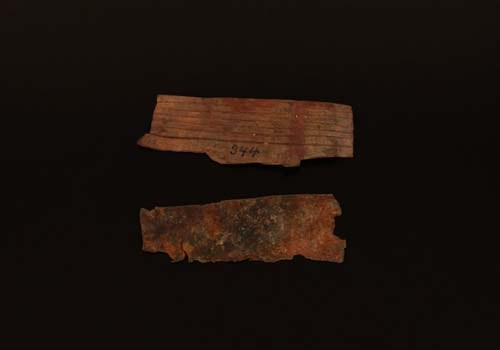Lithics
Lithics (or stones) have been used by many cultures to create tools such as knives, axes and arrowheads and have also lent themselves to being carved into ornate decorative items. The most common lithic material in most of Ontario's archaeological collections is chert, also sometimes called flint. Chert is an extremely fine-grained sedimentary rock which, thanks to the consistency of it's grain size, fractures in a predictable manner when struck. This allows chert tools to be extremely intricate and to include very sharp edges used for cutting. Because of these attributes and due to the ready availability of chert, it has been used by cultures around the world in the manufacture of versatile and effective cutting tools. The lithic artifacts in Sustainable Archaeology's include carved decorative items, intricately shaped points, disposable expedient tools created for temporary use, the by-products of tool manufacture (known as debitage), and more.
Ceramics
Just like today, cultures of the past most commonly used ceramic for implements related to food and cooking - a fact which can often be confirmed by the presence of burning or food traces found on fragments of ceramic artifacts. In addition to serving this everyday function, ceramic vessels are often highly decorative and may be stamped, incised, or painted. During the preparation of clay for making these vessels, substances such as sand, shell fragments, or fragments of old vessels may be added according to availability to improve the strength or aesthetic effect of the vessel. Because of the fragile nature of ceramic artifacts, the discovery of completely intact artifacts is rare. To aid in the analysis of tiny sherds most commonly found, archaeologists classify sherds based on whether they are part of body, neck, or rim of the original vessel. Although cooking vessels are the most common type of ceramic artifact, Sustainable Archaeology's ceramic collections also include smoking pipes.
Faunal
Faunal remains include any materials derived from animals. Most commonly, faunal assemblages are dominated by bones, teeth, and shell. For the early indigenous inhabitants of Ontario, animals were a highly versatile and indispensable resource, providing not only food, but also raw materials for the production of items such as tools and clothing. Because of this, faunal artifacts range from unworked remains, to worked bone tools and ornamental items such as bone and shell beads. Both worked and unworked faunal material is extremely valuable to archaeologists as unworked material can help determine diet and the season during which the site was occupied, while worked items can provide insight into the culture and technology of the site's occupants.
Archaeobotanical
Similar to faunal remains, archaeobotanical remains include any remnants of plant matter found at a site. Because plant matter tends to decompose very quickly, archaeobotanical remains are relatively rare and rely on particular taphonomic conditions. Plant remains used by past people are thought to be represented best in features. From these features, soil samples must be taken, processed and analysed. When they are preserved and later recovered and identified, these ancient plant parts can provide valuable insight into the lifestyle and diet of the site's inhabitants as well as the local environment. Some examples of floral remains include seeds, nutshell and charcoal.
Glass
Glass artifacts first begin to appear with the arrival of Europeans in North America, and often represent trade items. Glass artifacts can include beads as well as any of the many glass items we are familiar with today.
Metal
Metal artifacts (made of local copper) first began to appear in Ontario during the Archaic period. Metal has been used for many diverse purposes over time, and the artifacts in our collection include items such as beads, ornaments, axes, kettles, scrapers, and more.
